Have you ever wondered how low-calorie cat food impacts your feline friend's health? It's crucial to understand that weight management in cats is as important as in humans, and a balanced diet plays a key role. Low-calorie cat food can be an effective solution in preventing obesity and related health issues in your fur baby. But, it's not all about weight, is it? High-quality ingredients also contribute to skin and coat health. Are you curious to explore more about these benefits, how to choose the right product, and how to transition your cat to a healthier diet? Let's dive in.
Key Takeaways
- Low-calorie cat food aids in weight management and mitigates obesity-related health issues.
- Choose low-calorie cat food with high-quality proteins and fats, and limited carbohydrates.
- Gradually transition your cat to a low-calorie diet to prevent stress and allergies.
- Consult with a vet to tailor the low-calorie diet based on your cat's age, activity level, and health conditions.
- Regularly monitor your cat's weight while feeding low-calorie food to ensure healthy weight loss.
Understanding Cat Obesity
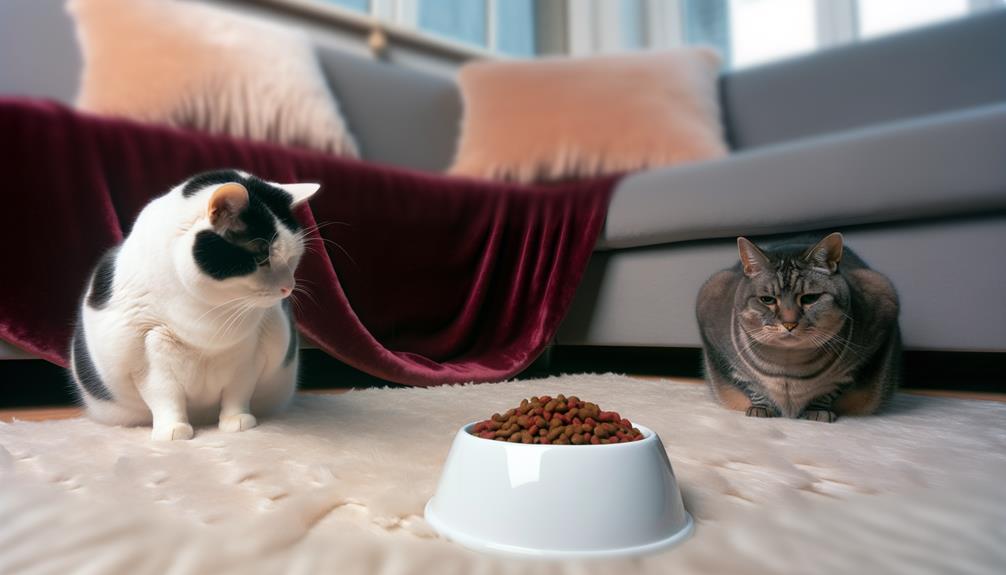
If you've noticed your furry friend packing on the pounds, it's essential to understand that cat obesity is a prevailing health issue with serious consequences. Recognizing obesity indicators early can help you nip this problem in the bud. You may notice your cat's belly sagging or that they're less active than usual. More obvious signs include trouble walking, shortness of breath, or an inability to groom properly.
Understanding the health risks associated with cat obesity is equally important. Obesity can lead to a range of serious health problems in cats, just like it does in humans. These risks include diabetes, arthritis, urinary tract diseases, and even certain types of cancer. Not only does obesity reduce your cat's quality of life, it can also shorten their lifespan.
The good news is, obesity is preventable and treatable. It's all about balance – ensuring your feline friend gets enough exercise and eats a diet suitable to their age, size, and health status. You'll also want to ensure that the food you're giving your cat isn't contributing to their weight gain.
In the end, it's about being an observant and responsible pet parent. If you suspect your cat is overweight, don't ignore the signs. Seek advice from a vet who can provide guidelines for a healthy weight and diet for your cat. Remember, a lean cat isn't just a healthier cat, but a happier one too.
Importance of Low-Calorie Diets
Switching your cat to a low-calorie diet can play a crucial role in managing their weight and enhancing their overall health. But it's not just about reducing the fat and carbohydrate content in their food. Caloric restrictions need to be balanced. It's about cutting back on excess without inducing nutritional deficiencies.
Yes, overweight cats are at risk for various health issues, including diabetes and heart disease. But underweight cats aren't healthy either. So, it's crucial to find the sweet spot. You don't want your cat to lose weight too rapidly, as this can lead to a dangerous condition called hepatic lipidosis, or fatty liver disease.
What's more, not all calories are created equal. While reducing the number of calories is important, it's equally essential to ensure your cat is getting the right kind of calories. This means focusing on high-quality proteins and fats, and the right amount of carbohydrates.
Remember, cats are obligate carnivores. This means they require a higher proportion of protein in their diet compared to dogs or humans. So, when implementing caloric restrictions, make sure that your cat's nutritional needs are met.
So how do you keep your cat's diet low in calories without causing nutritional deficiencies? It's all about balance and portion control. A vet or a pet nutritionist can guide you on how to create a balanced, nutrient-rich, low-calorie diet for your cat.
The key takeaway here is, a low-calorie diet can indeed help your cat maintain a healthy weight. But it must be implemented correctly, ensuring that your cat is still getting the necessary nutrients. A low-calorie diet doesn't mean low in nutrition.
Low-Calorie Cat Food Benefits
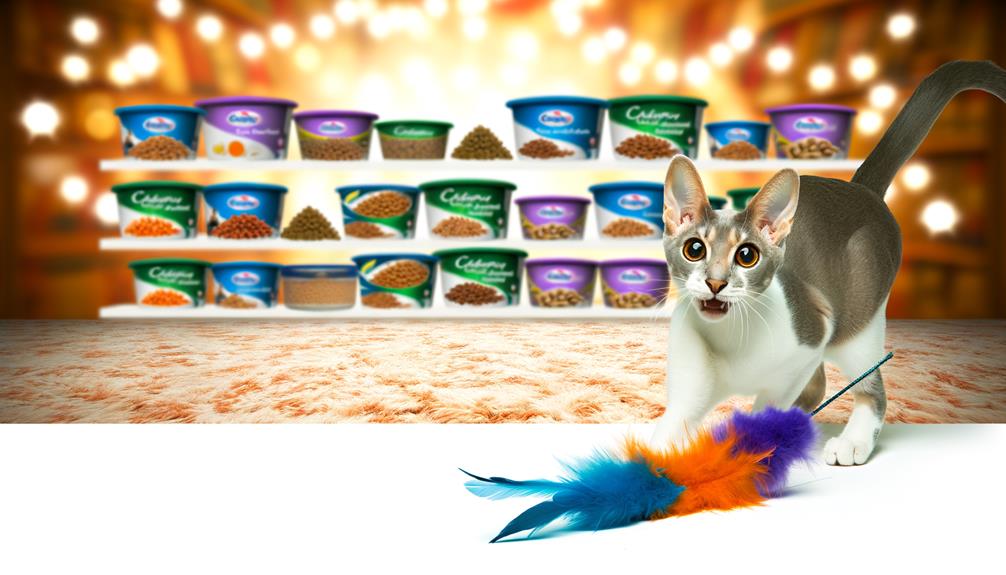
Feeding your cat low-calorie food has a host of benefits that go beyond mere weight management. These benefits are mainly due to the caloric restrictions that come with low-calorie cat food. It's not just about cutting back on calories, but rather, about providing a balanced diet that aligns with your cat's specific needs.
Caloric restrictions can help manage your feline's metabolism more effectively. A healthy metabolism is essential for your cat's overall well-being, aiding in digestion and energy production. With a lower-calorie diet, your cat's body can use the energy provided more efficiently, thus optimizing their metabolic processes.
Low-calorie cat food can also help mitigate the risk of obesity-related health issues. Too much weight can lead to numerous health problems in cats, including diabetes, heart disease, and arthritis. By controlling the calorie intake, you're helping your cat maintain a healthy weight, which can significantly reduce the risk of these health complications.
Another benefit is that low-calorie food often contains high-quality ingredients, which can improve your cat's skin and coat health. Good nutrition is reflected in a shiny, healthy coat and clear, bright eyes.
Moreover, feeding your cat a low-calorie diet can help increase their lifespan. Several studies have shown that caloric restrictions can contribute to longevity in various species, and the same goes for our feline friends.
Choosing the Right Cat Food
When it comes to picking out the perfect low-calorie food for your cat, you'll want to zero in on nutritional value, ingredient quality, and your cat's individual needs. It isn't just about cutting calories; it's about finding a balance that ensures your furry friend gets all the necessary nutrients while maintaining a healthy weight. Understanding your cat's nutritional requirements is crucial in this process.
Cats, unlike dogs, are obligate carnivores. This means they require a diet high in animal protein. A low-calorie cat food should still meet this protein requirement. Be wary of foods that cut calories by decreasing protein. Instead, look for ones that reduce calories by lowering the fat content, while still providing essential fatty acids.
Next, consider ingredient quality. Always check the label. You want meat to be the first listed ingredient, indicating it's the primary component. Avoid foods with lots of fillers like corn, wheat, and soy, which provide little nutritional value.
While choosing the right cat food, remember your cat's individual needs. If your cat has specific allergies, you'll need to take them into account. For instance, some cats are allergic to certain proteins like fish or beef. In such cases, a hypoallergenic diet might be the best option.
Lastly, consult with your vet. They can help you navigate the complexities of your cat's diet, taking into consideration factors like age, activity level, and existing health conditions. Remember, the best low-calorie cat food will vary from cat to cat. It's about finding the right balance for your furry friend.
Top Low-Calorie Cat Food Brands
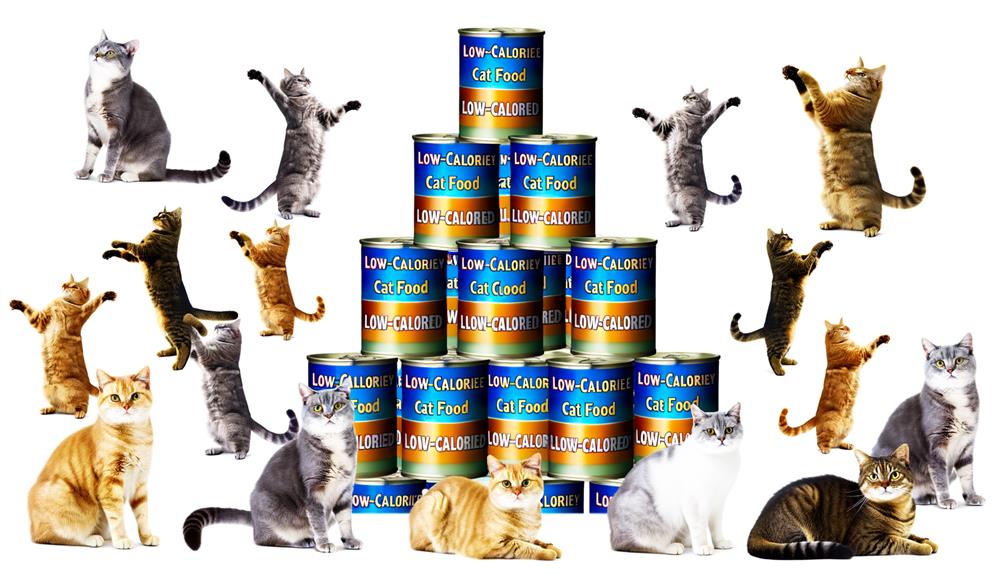
Now that you're equipped with the knowledge on how to pick the right low-calorie food for your cat, let's explore some of the top brands that you can consider. These brands are selected based on ingredient analysis and their attention to dietary allergens.
Firstly, Hill's Science Diet offers a low-calorie cat food option that's widely recognized for its high-quality ingredients. Their Indoor Dry Cat Food contains lean proteins like chicken, alongside a range of essential nutrients. It's also tailored to minimize potential dietary allergens, making it a safe choice for cats with food sensitivities.
Secondly, Nutro's Weight Management Cat Food is another excellent choice. It's crafted with real chicken and whole grains, providing a balanced diet with reduced calories. This brand is also noted for its stringent ingredient analysis, ensuring your cat gets only the best.
Blue Buffalo's Weight Control Natural Adult Dry Cat Food is another popular choice. It's packed with real meat, fruits, and veggies, all while keeping the calorie count low. It's a brand that pays close attention to dietary allergens, making it a great pick for cats with specific dietary needs.
Lastly, there's Natural Balance's Fat Cats Low Calorie Dry Cat Food. It boasts a balanced blend of protein and fiber, which helps to keep your cat feeling full without overloading on calories. The brand's rigorous ingredient analysis guarantees that only premium, low-allergen ingredients make it into their food.
Transitioning to a Low-Calorie Diet
Switching your cat to a low-calorie diet can be a crucial step in managing their weight and overall health. However, the transition isn't always easy and requires patience and careful planning. It's essential to bear in mind that not all cats will respond similarly to diet changes, especially those with food allergies.
You're probably wondering how cat allergies come into play. When transitioning to a low-calorie diet, you might introduce new foods that your cat hasn't eaten before. If your cat has an allergy, this could lead to discomfort and even health issues. To avoid this, it's best to do a bit of research on the ingredients of the low-calorie food before making the switch.
Now, you can't just switch your cat's food from one day to the next. Cats are creatures of habit and sudden changes in diet can stress them out. Start by mixing a small amount of the low-calorie food with their regular food. Gradually increase the amount of low-calorie food while decreasing the regular food over a week or two.
But what if your cat doesn't take to the new food? That's where palatable options come in. Low-calorie doesn't have to mean low taste. There's a wide variety of tasty, low-calorie cat food available on the market. Some brands even offer options specially designed to appeal to picky eaters.
Feeding Schedules and Portions
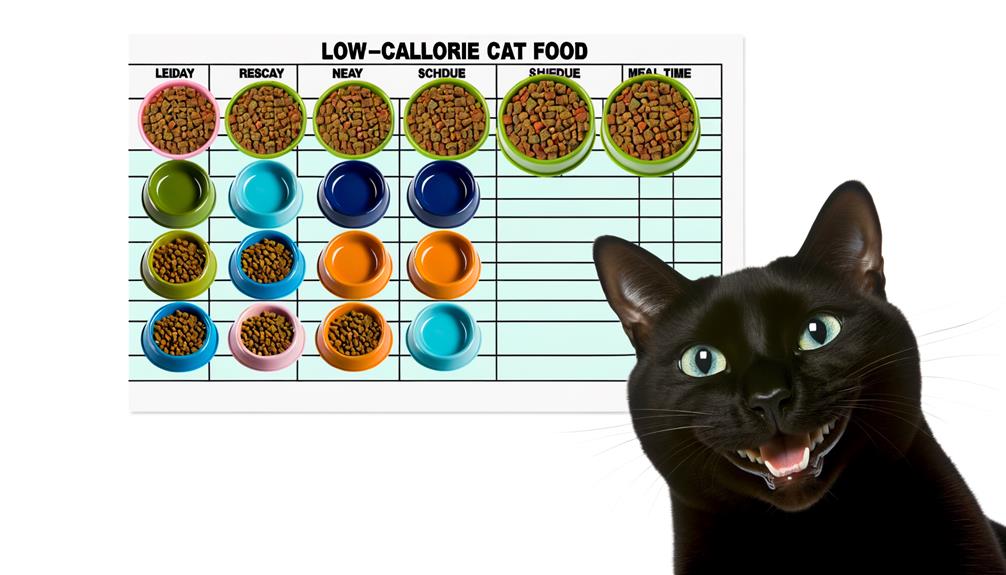
After you've found a low-calorie food that your cat enjoys, it's time to consider how often and how much they should be eating. Meal timing is an essential factor in maintaining your feline's health. You can't just fill up the bowl and let them have at it whenever they please. Cats, unlike dogs, are natural grazers who prefer to eat small meals throughout the day.
Establish a fixed feeding schedule. Most cats do well with two meals a day, one in the morning and one in the evening. If your cat prefers smaller, more frequent meals, you might want to consider an automatic feeder that can dispense portion-controlled meals throughout the day.
When it comes to portion sizes, it's not a one-size-fits-all scenario. The right amount depends on your cat's weight, age, and activity level. A sedentary senior cat will need fewer calories than a playful kitten. Make sure to follow the feeding guide on your cat's food packaging, or better yet, consult with your vet for personalized advice.
Feline hydration is another crucial aspect to consider. Cats aren't great drinkers, and they often get the majority of their water from their food. If you're feeding your cat a dry low-calorie diet, ensure they've access to fresh water at all times. You might also want to consider supplementing their diet with wet food, which has a higher water content.
Monitoring Your Cat's Weight
Keeping a close eye on your cat's weight is a crucial part of their low-calorie diet plan. It ensures they're losing weight at a healthy rate and not starving due to the dietary changes. Your first step is to determine your cat's ideal weight, then employ weight tracking methods to monitor progress.
Weight tracking doesn't have to be complex. You can use a regular bathroom scale to weigh your cat. All you have to do is to weigh yourself first, then pick up your cat and step on the scale again. The difference between the two weights is your cat's weight. It's a good idea to track this weekly to notice any trends.
Another method is observing physical and behavioral changes. If your cat has a healthy weight, you should be able to feel but not see their ribs. Too much fat covering the ribs is an indication of overweight, while protruding ribs signify underweight. Furthermore, behavioral changes like increased laziness, lack of grooming, or difficulty jumping on furniture might indicate weight issues.
If you notice your cat's weight fluctuating too much or if they seem unhappy or unwell, it's best to consult a veterinarian. They can provide you with more precise weight tracking methods and guide you on how to adjust your cat's diet accordingly.
Veterinarian's Role in Diet Planning
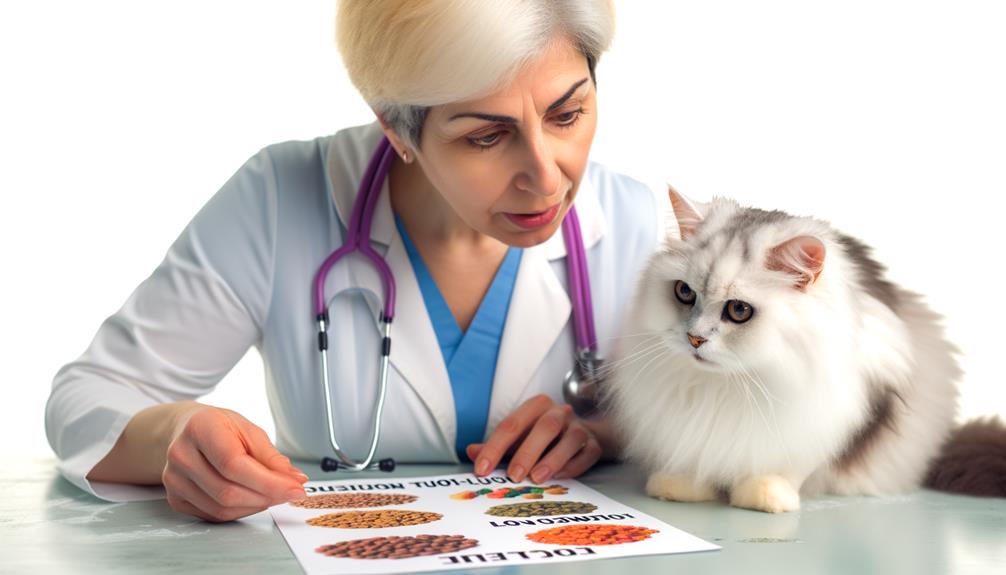
Don't underestimate the role your vet plays in planning your cat's diet. They're pivotal in tailoring a meal plan that fits your feline's specific needs.
Importance of Vet Consultation
Consulting your vet is a crucial step before switching your cat to low-calorie food. Your vet's expertise is vital in determining whether a low-calorie diet is right for your feline friend. They'll consider your cat's age, weight, and lifestyle, but they'll also delve deeper.
Medical conditions can significantly impact your cat's dietary needs. Issues like diabetes, thyroid problems, or kidney disease could necessitate specific dietary adjustments. Furthermore, sudden weight loss can signal health problems, which your vet can help identify.
Tailoring Cat's Diet Plan
After getting your vet's approval to switch to low-calorie food, it's important to work closely with them to tailor a diet plan that suits your cat's unique needs. Your vet's expertise is crucial in identifying potential dietary allergies and preventing nutrient deficiency. They'll assess your cat's health, age, weight, and lifestyle to determine the appropriate nutritional balance.
Remember, cats need a diet rich in proteins and certain fats. A sudden switch to low-calorie food may deprive them of these essential nutrients. You mightn't recognize the signs of nutrient deficiency, but your vet will. They'll monitor your cat's health and adjust the diet accordingly.
Don't risk your cat's health. Trust your vet to design a safe, balanced, low-calorie diet plan, minimizing potential health risks.
Exercise and Cat Weight Management
Switching your cat to low-calorie food isn't the only step towards a healthier lifestyle.
You should also consider an exercise routine that fits your feline's needs and recognizes the importance of play.
Feline Fitness Routines
To keep your cat in ideal shape, it's crucial to integrate regular exercise into their routine along with a balanced, low-calorie diet. Interactive toys can be a great way to get your feline friend moving. Cats, being natural hunters, are attracted to toys that simulate prey. A mouse toy or a laser pointer can encourage active play and keep them engaged.
Outdoor exploration is another excellent way to keep your cat fit. It provides ample opportunities for climbing, running, and jumping. However, ensure the area is safe and secure.
Importance of Play
Your cat's playtime isn't just fun, it's a critical component of their weight management and overall health. Interactive toys play a key role in keeping your cat moving. They'll jump, chase, and pounce, mimicking the hunting behaviors they'd use in the wild. This not only provides them with mental stimulation but also helps burn off those extra calories.
Playtime duration is equally important as the type of play. It's not enough to throw a toy mouse and call it a day. You've got to be actively engaged in the play, making it a fun and rewarding experience for both of you. Regular, structured play sessions can help keep your cat's weight in check, making it an essential part of their daily routine.
Diet Versus Exercise
While exercise is a key component in keeping your furry friend fit, it's important to remember that a balanced, low-calorie diet plays an equally vital role in cat weight management. Just as in human obesity comparisons, your cat's weight can't be effectively managed with exercise alone.
It's the combination of a healthy diet and regular physical activity that's most effective for weight loss and maintenance. Overweight cats, like obese humans, are at risk for weight-related diseases such as diabetes, heart disease, or arthritis.
Frequently Asked Questions
Can Low Calorie Cat Food Cause Nutritional Deficiencies in Cats?
Yes, it can. If you're not careful, feeding your cat a low-calorie diet can lead to calorie deficiency signs and nutrient absorption issues. Always ensure you're providing a balanced diet for your furry friend.
How Does Age Affect a Cats Calorie Requirements?
Your cat's age significantly impacts its calorie needs. Kittens require more for growth, while senior cats' metabolism slows down, reducing their caloric needs. It's crucial you adjust their diet accordingly to maintain overall health.
What Are Some Homemade Low-Calorie Cat Food Recipes?
You're asking about homemade cat food recipes that are low in calories. Keep in mind diet variation effects and potential feline allergen concerns. Boiled chicken breast, pumpkin, and peas are great ingredients to start with.
Are There Specific Breeds That Require More Low-Calorie Food?
Yes, breed-specific diets can be crucial. Some breeds, like the Maine Coon or Persian, are more prone to obesity and thus, might benefit more from low-calorie food for optimal health and obesity prevention.
Can I Mix Low-Calorie Cat Food With Regular Cat Food?
Absolutely, you can mix regular and low-calorie cat food. It's all about portion control and maintaining a balanced feeding schedule. Just ensure your cat's getting the right nutrients and not overeating.
Conclusion
Maintaining your cat's weight with low-calorie food is a crucial part of their overall health. It aids in preventing obesity-related issues and promotes a healthier coat.
Remember to transition gradually, keeping in mind your cat's preferences and potential allergies. Regular weight monitoring, consulting with your vet, and ensuring exercise is part of their routine will all contribute to successful weight management.
Here's to a healthier, happier feline friend!







